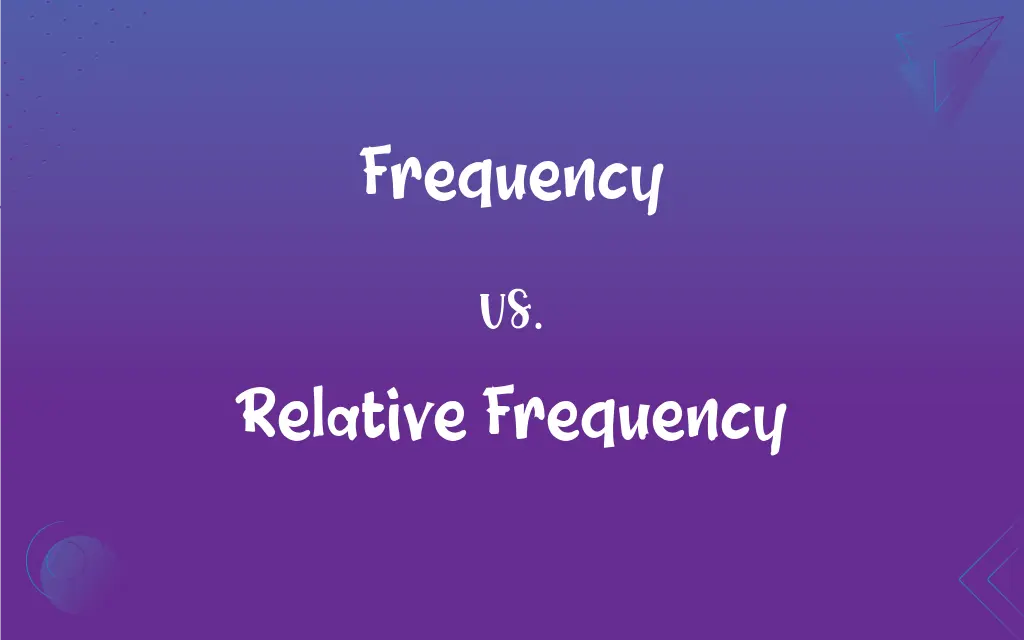Frequency vs. Relative Frequency: What's the Difference?
Edited by Aimie Carlson || By Janet White || Published on December 25, 2023
Frequency is the count of occurrences, while relative frequency is the proportion of each occurrence to the total count.

Key Differences
Frequency refers to the number of times an event occurs, often used in statistics and data analysis to count occurrences. Relative frequency, on the other hand, provides a contextual understanding of these counts by expressing the frequency as a fraction or percentage of the total number of occurrences.
In measuring data, frequency gives a raw count, such as the number of blue balls in a jar. Relative frequency goes a step further by calculating the ratio of blue balls to the total number of balls, providing a more nuanced understanding.
Frequency is an absolute measure and does not consider the size of the sample. In contrast, relative frequency, by taking into account the total sample size, offers a comparative perspective, allowing for a better understanding of the significance of the frequency in a broader context.
When presenting data, frequency is often displayed in a frequency table or histogram, showing the straightforward count of occurrences. Relative frequency, however, is typically presented in a pie chart or a percentage histogram, illustrating the proportion of each category relative to the whole.
In research, frequency is essential for identifying the prevalence of specific outcomes, whereas relative frequency is crucial for comparing these outcomes across different samples or categories, providing a more balanced view of the data.
ADVERTISEMENT
Comparison Chart
Definition
Count of occurrences of an event or item.
Proportion of each occurrence in relation to the total count.
Measurement Type
Absolute number.
Proportional or percentage value.
Context
Useful for raw data analysis.
Useful for comparative analysis.
Presentation
Often shown in histograms or tables.
Typically represented in pie charts or percentage histograms.
Research Utility
Identifies prevalence or count of outcomes.
Compares outcomes across different samples or categories.
ADVERTISEMENT
Frequency and Relative Frequency Definitions
Frequency
In statistics, frequency refers to the number of times an event or value occurs.
The frequency of rolling a six in the dice game was surprisingly low.
Relative Frequency
In analysis, relative frequency helps in comparing the occurrences of different events or categories.
The relative frequency of different brands shows which is most popular among consumers.
Frequency
In linguistics, frequency denotes how often a word or phrase appears within a language.
The frequency of the word love in romantic novels is very high.
Relative Frequency
In statistics, relative frequency is used to describe the proportion of a particular outcome.
The relative frequency of choosing a red ball from the bag was 20%.
Frequency
Frequency is the rate at which something occurs over a particular period.
The frequency of earthquakes in this region is quite high.
Relative Frequency
It reflects the likelihood or probability of an event occurring in an experiment.
The relative frequency of rain in July gives us an idea of its probability.
Frequency
In physics, frequency is the number of waves that pass a point in a second.
The frequency of the sound wave determines its pitch.
Relative Frequency
Relative frequency can also indicate the distribution of various categories in a dataset.
The relative frequency of each grade level shows the diversity of the student population.
Frequency
In digital technology, frequency refers to the rate at which a processor can execute instructions.
The new processor has a higher frequency, leading to faster performance.
Relative Frequency
Relative frequency is the ratio of the number of times an event occurs to the total number of trials.
The relative frequency of getting heads in 100 coin tosses was 0.45.
Frequency
The property or condition of occurring at frequent intervals.
Frequency
The number of repetitions of a complete sequence of values of a periodic function per unit variation of an independent variable.
FAQs
What is frequency?
Frequency is the count of how often an event or item occurs.
How is relative frequency calculated?
By dividing the frequency of an event by the total number of occurrences.
Is frequency used in everyday language?
Yes, often to describe how often something happens.
Why is relative frequency important?
It provides context by showing the proportion of an event relative to the total.
Does relative frequency change with sample size?
Yes, it may change as it's dependent on the total number of occurrences.
Is relative frequency always less than 1?
Yes, since it's a proportion of the total, it's always between 0 and 1.
Can frequency be a negative number?
No, frequency is always a non-negative integer.
How does frequency differ in statistics and physics?
In statistics, it's about event counts; in physics, it's about wave cycles per second.
Is high frequency always desirable?
It depends on context; high frequency can be either positive or negative.
How does frequency impact data representation?
It influences how data is visualized in charts and graphs.
Can frequency be used to predict future events?
It can suggest trends but not precisely predict future events.
Can frequency be zero?
Yes, if an event does not occur at all.
Does relative frequency add up to 1 in a complete dataset?
Yes, the sum of relative frequencies in a complete dataset is 1.
Can frequency be used to analyze trends?
Yes, it can indicate emerging patterns or trends in data.
Is relative frequency subjective?
No, it's an objective measure based on actual data counts.
Can frequency be a decimal?
No, frequency is always an integer.
Why is relative frequency useful in probability?
It approximates the likelihood of an event occurring.
What role does relative frequency play in surveys?
It helps in understanding the proportion of different responses.
Can relative frequency exceed 1?
No, it's always equal to or less than 1.
How does relative frequency help in data analysis?
It allows for comparison between different sets of data.
About Author
Written by
Janet WhiteJanet White has been an esteemed writer and blogger for Difference Wiki. Holding a Master's degree in Science and Medical Journalism from the prestigious Boston University, she has consistently demonstrated her expertise and passion for her field. When she's not immersed in her work, Janet relishes her time exercising, delving into a good book, and cherishing moments with friends and family.
Edited by
Aimie CarlsonAimie Carlson, holding a master's degree in English literature, is a fervent English language enthusiast. She lends her writing talents to Difference Wiki, a prominent website that specializes in comparisons, offering readers insightful analyses that both captivate and inform.

































































